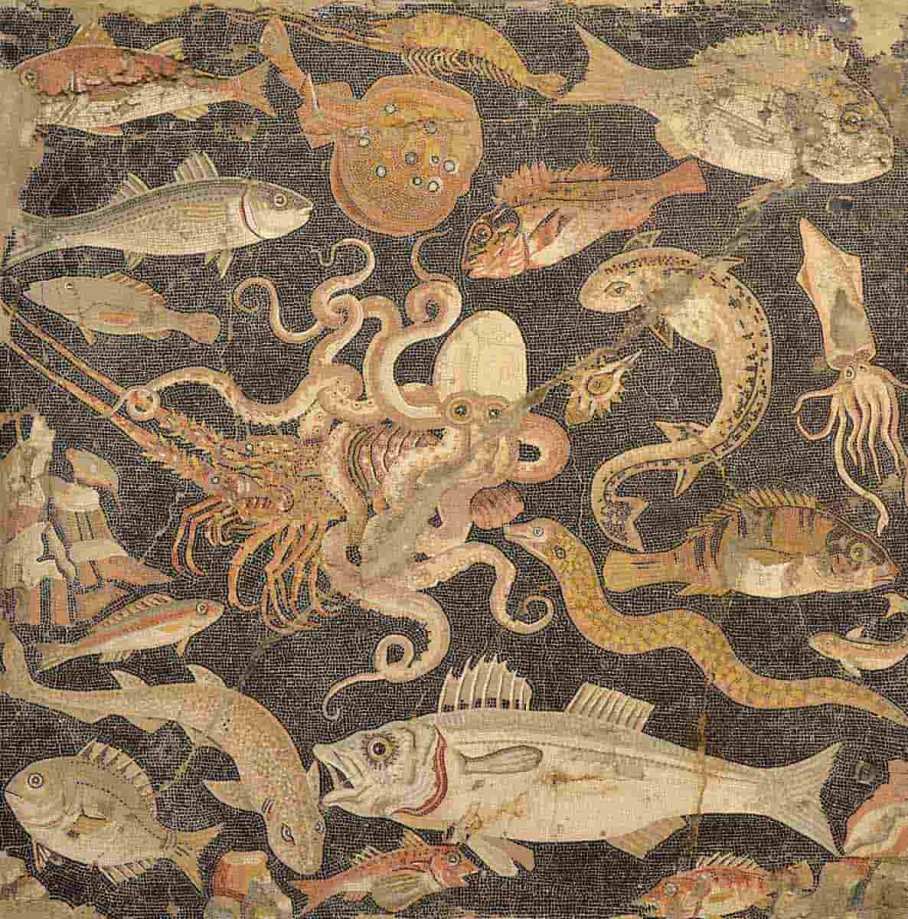A Marvel of Ancient Artistry
Imagine a Roman mosaic so detailed and lifelike it continues to awe viewers over two millennia later. This masterpiece, discovered in the ruins of Pompeii and now preserved in the Naples National Archaeological Museum, celebrates the beauty of marine life. Fish, eels, octopuses, and other sea creatures are intricately depicted, demonstrating the Romans’ artistic mastery and their profound connection to the sea.

Crafted during the late Roman Republic, the mosaic reflects the unmatched skill of Roman artisans who used tiny tesserae—small pieces of colored stone, glass, or ceramic—to achieve photorealistic effects. The interplay of light and shadow on shimmering fish scales and the curling tentacles of an octopus creates the illusion of motion, making the mosaic appear almost alive.
The Role of Mosaics in Roman Culture
This marine-themed mosaic was likely the centerpiece of a luxurious Roman domus, possibly in the dining area, or triclinium. Such mosaics served not only as decorations but also as status symbols, showcasing the wealth and cultural sophistication of the homeowner. Themes often celebrated abundance, with marine motifs symbolizing prosperity, trade, and the Romans’ reliance on the sea for sustenance.
The presence of these mosaics also hints at religious undertones. Many marine-themed works paid homage to Neptune, the Roman god of the sea, reflecting the deity’s importance in daily Roman life. In a society so deeply connected to maritime trade and travel, mosaics such as this one conveyed reverence for the natural and divine forces shaping their world.
Pompeii: A Treasure Trove of Mosaics
Pompeii, a city frozen in time after the catastrophic eruption of Mount Vesuvius in 79 CE, has provided invaluable insights into Roman life through its well-preserved artifacts. Among these, mosaics stand out as some of the most compelling examples of ancient artistry. The marine mosaic belongs to a broader collection of works that also includes mythological scenes, portraits, and the renowned Alexander Mosaic, depicting the Battle of Issus with stunning detail and dynamism.
These mosaics were more than decorative—they were storytelling devices, immortalizing scenes of daily life, epic battles, and the natural world. Their placement in homes and public spaces emphasized their cultural and social significance, reflecting the values and aspirations of Roman society.
A Timeless Legacy
The marine mosaic from Pompeii is more than an artifact; it is a time capsule preserving the essence of Roman civilization. Its intricate details remind us of a society that found wonder and inspiration in the natural world, transforming everyday experiences into enduring works of art.
Today, as it resides in the Naples National Archaeological Museum, this mosaic continues to captivate visitors, serving as a testament to the ingenuity and vision of Roman artisans. It offers a glimpse into a world where the ordinary was celebrated and the extraordinary was immortalized—a legacy as vibrant and dynamic as the marine life it depicts.

